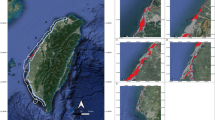Abstract
Coastal vegetated shingle is a rare and declining resource worldwide but is found extensively around the UK coastline. Shingle sediments b-axes range between 2 mm and 200 mm and occur as fringing beaches, bars, spits, barrier islands and forelands. Sediment patterns are dependent upon accretion or erosion. With sea-level rise, shingle features tend to move inland. Larger features may support reservoirs of fresh water but risk becoming saline with sea-level rise. Ranker soils may develop but are naturally fragile. Vegetated shingle communities are dependent upon substrate stability, moisture and nutrient availability. Only specialized and some ruderal plants can persist in patterns dependent upon geomorphic history. Coastal defence, agriculture, public access and control of alien species are important factors in habitat management. Because of its dynamic and unusual nature coastal vegetated shingle is an important habitat for environmental education.
Similar content being viewed by others
Abbreviations
- BAP:
-
Biodiversity Action Plan
- LNR:
-
Local Nature Reserve
References
Bluck, B.J. 1967. Sedimentation of beach gravels: examples from South Wales.J. Sediment. Petrol. 37: 125–156.
Bradbury, A.P. & Kidd, R. 1998.Hurst Spit stabilisation scheme—design and construction of beach recharge. Proceedings of the 33rd MAFF Conference of River and Coastal Engineers, pp. 1.1.1.-1.1.13. Keele University, UK.
Carter, R.W.G. & Orford, J.D. 1993. The morphodynamics of coarse clastic beaches and barriers: a short and long term perspective.J. Coastal Res. 15: 158–179.
Chapman, V.J. 1947. Biological flora of the British Isles:Suaeda fruticosa Forsk.J. Ecol. 35: 303–310.
Connell, J.H. & Slatyer, R.O. 1977. Mechanisms of succession in natural communities and their role in community stability and organisation.Am. Nat. 111: 1119–1144.
Doody, J.P. & Randall, R.E. 2003.Guidance for the management of coastal vegetated shingle. English Nature, Peterborough, UK.
Farrell, L. & Randall, R.E. 1992. The distribution ofMertensia maritima (L.) Gray, Oyster Plant, in Ireland.Irish Nat. J. 24: 135–140.
Ferry, B.W. 2001. Vegetation of Dungeness shingle: aspects of biodiversity. In: Packham, J.R., Randall, R.E., Barnes, R.S.K. & Neal, A. (eds.)Ecology & geomorphology of coastal shingle, pp. 224–241. Westbury Publishing, Otley, UK.
Ferry, B., Lodge, N. & Waters, S. 1989Dungeness: a vegetation survey of a shingle beach. Research & Survey in nature conservation, No 26: Nature Conservancy Council, Peterborough, UK.
Forbes, D.L., Taylor, R.B., Orford, J.D., Carter, R.W.G. & Shaw, J. 1991. Gravel barrier migration and overstepping.Mar. Geol. 97: 305–313.
Fuller, R.M. 1987. Vegetation establishment on shingle beaches.J. Ecol. 75: 1077–1089.
Gleason, H.A. 1926. The individualistic concept of the plant association.Bull. Torrey Bot. Club 53: 7–26.
Kidson, C. 1959. Uses and limits of vegetation in shore stabilisation.Geography 44: 241–247.
Kirk, R.M. 1980. Mixed sand and gravel beaches: morphology, processes and sediments.Progr. Phys. Geogr. 4: 189–210.
Oliver, F.W. 1912. The shingle beach as a plant habitat.New Phytol. 11: 73–99.
Orford, J.D. et al. 2001. Origin, development, reworking and breakdown of gravel-dominated coastal barriers in Atlantic Canada: future scenarios for the British Coast. In: Packham, J.R., Randall, R.E., Barnes, R.S.K. & Neal, A. (eds.)Ecology & geomorphology of coastal shingle, pp. 23–55. Westbury Publishing, Otley, UK.
Packham, J.R., Randall, R.E., Barnes, R.S.K. & Neal, A. (eds.) 2001.Ecology and geomorphology of coastal shingle. Westbury Publishing, Otley UK.
Peterken, G.F. & Hubbard, J.C.E. 1972. The shingle vegetation of southern England: the holly wood on Holmestone Beach, Dungeness.J. Ecol. 60: 547–571.
Pye, K. 2001. The nature and geomorphology of coastal shingle. In: Packham, J.R., Randall, R.E., Barnes, R.S.K. & Neal, A. (eds.)Ecology & geomorphology of coastal shingle, pp. 2–22. Westbury Publishing, Otley, UK.
Randall, R.E. 1973. Shingle Street, Suffolk: an analysis of a geomorphic cycle.Bull. Geol. Soc. Norfolk 24: 15–35.
Randall, R.E. 1977. Shingle foreshores. In: Barnes, R.S.K. (ed.)The Coastline, pp. 49–61. Wiley, London, UK.
Randall, R.E. 1992. The shingle vegetation of the coastline of New Zealand: Nelson Boulder Bank and Kaitorete Spit.N.Z. J. Geogr. 93: 11–19.
Randall, R.E. & Doody, J.P. 1995. Habitat inventories and the European Habitats Directive: the example of shingle beaches. In: Healy, M.J. & Doody, J.P. (eds)Directions in European coastal management, pp. 19–36. Samara Publishing, Cardigan, UK.
Randall, R.E. & Fuller, R.M. 2001. The Orford Shingles, Suffolk, UK: Evolving solutions in coastline management. In: Packham, J.R., Randall, R.E., Barnes, R.S.K. & Neal, A. (eds.)Ecology & geomorphology of coastal shingle, pp. 242–260. Westbury Publishing, Otley, UK.
Randall, R.E. & Sneddon, P. 2001. Initiation, development and classification of vegetation on British shingle beaches: a model for conservation management. In: Packham, J.R., Randall, R.E., Barnes, R.S.K. & Neal, A. (eds.)Ecology & geomorphology of coastal shingle, pp. 202–223. Westbury Publishing, Otley, UK.
Salisbury, E.J. 1952.Downs and dunes: their plant life and its environment. Bell, London, UK.
Scott, G.A.M. 1963. The ecology of shingle beach plants.J. Ecol. 51: 517–527.
Scott, G.A.M. 1965. The shingle vegetation at Dungeness.J. Ecol. 53: 21–31.
Shulmeister, J. & Kirk, R.M., 1993. Evolution of a mixed sand and gravel barrier system in Canterbury, New Zealand, during the Holocene sea-level rise and still stand.Sediment. Geol. 87: 215–235.
Sneddon, P. & Randall, R.E. 1993/1994.Shingle survey of Great Britain. Final Report Appl. 1. Wales, App. 2, Scotland. Appl. 3: England. Joint Nature Conservation Committee, Peterborough, UK.
Walmsley, C.A. & Davy, A.J. 2001. Habitat creation and restoration of damaged shingle communities. In: Packham, J.R., Randall, R.E., Barnes, R.S.K. & Neal, A. (eds.)Ecology & geomorphology of coastal shingle, pp. 409–420. Westbury Publishing, Otley, UK.
Whittaker, R.H. 1957. Recent evolution of ecological concepts in relation to the eastern forests of North America.Am. J. Bot. 44: 197–206.
Author information
Authors and Affiliations
Rights and permissions
About this article
Cite this article
Randall, R.E. Management of coastal vegetated shingle in the United Kingdom. J Coast Conserv 10, 159–168 (2004). https://doi.org/10.1652/1400-0350(2004)010[0159:MOCVSI]2.0.CO;2
Received:
Revised:
Accepted:
Issue Date:
DOI: https://doi.org/10.1652/1400-0350(2004)010[0159:MOCVSI]2.0.CO;2




